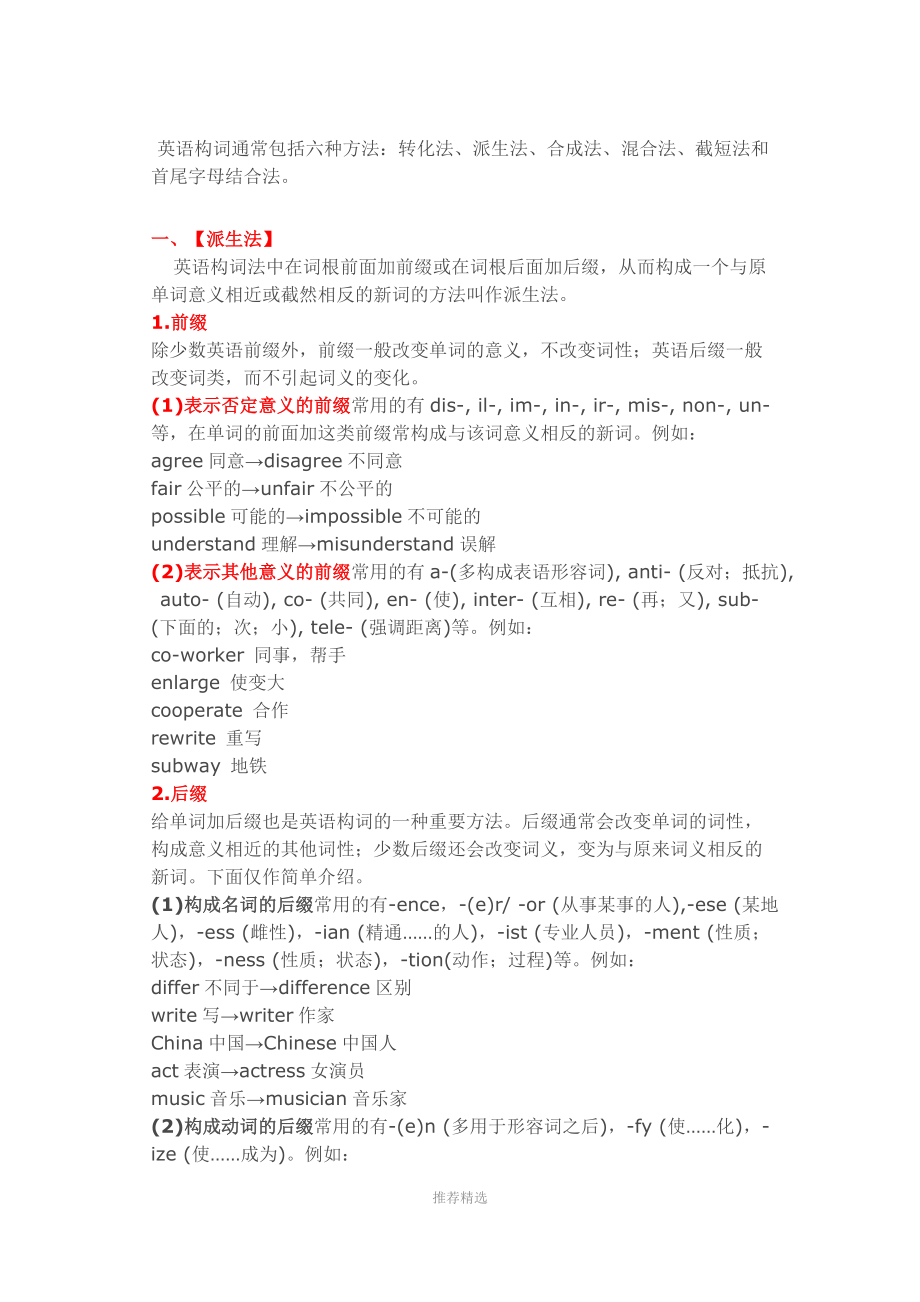 常见英语构词法包括六种方法
常见英语构词法包括六种方法



《常见英语构词法包括六种方法》由会员分享,可在线阅读,更多相关《常见英语构词法包括六种方法(12页珍藏版)》请在装配图网上搜索。
1、英语构词通常包括六种方法:转化法、派生法、合成法、混合法、截短法和首尾字母结合法。一、【派生法】 英语构词法中在词根前面加前缀或在词根后面加后缀,从而构成一个与原单词意义相近或截然相反的新词的方法叫作派生法。1.前缀除少数英语前缀外,前缀一般改变单词的意义,不改变词性;英语后缀一般改变词类,而不引起词义的变化。(1)表示否定意义的前缀常用的有dis-, il-, im-, in-, ir-, mis-, non-, un-等,在单词的前面加这类前缀常构成与该词意义相反的新词。例如:agree同意disagree不同意fair公平的unfair不公平的possible可能的impossible不
2、可能的understand理解misunderstand误解(2)表示其他意义的前缀常用的有a-(多构成表语形容词), anti- (反对;抵抗), auto- (自动), co- (共同), en- (使), inter- (互相), re- (再;又), sub- (下面的;次;小), tele- (强调距离)等。例如:co-worker 同事,帮手enlarge 使变大cooperate 合作rewrite 重写subway 地铁2.后缀给单词加后缀也是英语构词的一种重要方法。后缀通常会改变单词的词性,构成意义相近的其他词性;少数后缀还会改变词义,变为与原来词义相反的新词。下面仅作简单介
3、绍。(1)构成名词的后缀常用的有-ence,-(e)r/ -or (从事某事的人),-ese (某地人),-ess (雌性),-ian (精通的人),-ist (专业人员),-ment (性质;状态),-ness (性质;状态),-tion(动作;过程)等。例如:differ不同于difference区别write写writer作家China中国Chinese中国人act表演actress女演员music音乐musician音乐家(2)构成动词的后缀常用的有-(e)n (多用于形容词之后),-fy (使化),-ize (使成为)。例如:推荐精选widewiden加宽beautybeautify
4、美化purepurify提纯realrealize意识到organorganize组织sharpsharpen使变锋利(3)构成形容词的后缀常用的有-al,-able (有能力的),-(a)n(某国人的),-en (多用于表示材料的名词后),-ern (方向的),-ese(某国人的),-ful,-(ic)al,-ish,-ive,-less (表示否定),-like (像的),-ly,-ous,-some,-y (表示天气)等。例如:nature自然natural自然的reason道理reasonable有道理的America美国American美国的China中国Chinese中国人的gol
5、d金子golden金的east东eastern东方的child孩子childish孩子气的snow雪snowy雪的(4)构成副词的常用后缀有-ly (主要用于形容词之后表示方式或程度),-ward(s) (主要用于表示方位的词之后表示方向)。例如:angry生气的angrily生气地to到towards朝,向east东方eastward向东(5)构成数词的后缀有-teen (十几),-ty (几十),-th (构成序数词)。例如:six六sixteen十六sixteenth第十六four四forty四十fortieth第四十二、【合成法】英语构词法中把两个单词连在一起合成一个新词,前一个词修饰
6、或限定后一个词,这样的方法就是合成法。1.合成名词 名词名词weekend周末 名词动词daybreak黎明 名词动名词handwriting书法推荐精选 名词及物动词eror pain-killer止痛药 名词介词名词sister-in-law嫂子 代词名词she-wolf母狼 动词名词typewriter打字机 动名词名词reading-room阅览室 现在分词名词flying-fish飞鱼 形容词名词freshman大一新生 副词动词outlook景色,风光 介词名词afterbrain后脑2.合成形容词名词形容词bloodred血红的名词现在分词French-speaking讲法语的名
7、词to名词one-to-one一对一的名词过去分词man-made人造的数词名词one-way单行道的数词名词形容词three-year-old三岁的数词名词ed ten-storeyed十层的动词副词one-off 一次性的形容词名词high-quality高质量的形容词名词ed noble-minded高尚的形容词形容词light-green浅绿色的形容词现在分词ordinary-looking相貌一般的副词形容词ever-green常青的副词现在分词hard-working辛勤的副词过去分词well-known著名的副词名词fast-food专门提供快餐服务的介词名词indoor室内的3
8、.合成动词名词动词sleep-walk梦游形容词动词white-wash粉刷副词动词overwhelm压倒,制服4.合成副词形容词名词hotfoot匆忙地形容词副词everywhere到处副词副词however尽管如此介词名词beforehand事先介词副词forever永远5.合成代词推荐精选代词宾格self herself 她自己物主代词self myself 我自己形容词名词anything 一切6.合成介词副词名词outside在外面介词副词within在之内副词介词into进入三、【转化法】英语构词法中把一种词性用作另一种词性而词形不变的方法叫作转化法,有的名词可以作动词,有的形容词
9、可以作副词或动词。1.动词转化为名词1)意思没有变化,例如:I think wed better finish the talk now.我想我们的谈话最好现在结束。2)意思有一定变化,例如:He is a man of strong build.他是一个体格健壮的汉子。3)构成短语,例如:Lets have a look first. 我们先看一下吧。2.名词转化为动词1)表示物体的,如:Have you booked the ticket?你订好票了吗?2)表示身体部位的,如:Hand in your papers please.请把你们的试卷交上来。3)表示一类人的,如:She nurs
10、ed her husband back to health.她看护丈夫,使他恢复了健康。4)抽象名词,如:We breakfasted together.我们在一起吃了早餐。3.形容词转化为动词少数形容词可以转化为动词。例如:We will try our best to better our living conditions.我们要尽力改善我们的生活状况。4.副词转化为动词有少数副词可以转化为动词。例如:Murder will out.恶事终必将败露。5.形容词转化为名词1)表示颜色的形容词常可转化为名词,如:The girl in black appears very beautiful
11、.那个穿黑衣服的女孩子看上去非常漂亮。2)一些形容词如old, young, poor, rich, wounded, injured等与the连用,表示一类人,作主语时,谓语用复数,如:We dont belong to the rich, but we dongt belong to the poor either. 我们不是有钱人,但我们也不是穷人。推荐精选四、【截短法(缩略法)】将单词缩写,词义和词性保持不变的英语构词法称为截短法,主要有截头、去尾、截头去尾等形式。1.截头telephonephoneairplaneplane2.去尾mathematicsmathsexaminatio
12、nexamkilogramkilolaboratorylabtaxicabtaxi3.截头去尾influenzaflurefrigeratorfridgeprescriptionscript五、【混合法(混成法)】英语构词还可以将两个词混合或各取一部分紧缩而成一个新词,前半部分表属性,后半部分表主体。这样的英语构词法就是混合法。news broadcastnewscast新闻广播television broadcasttelecast电视播送smoke and fogsmog烟雾photo and graphyphotography摄影,摄影术helicopter airporthelipor
13、t直升飞机场六、【首尾字母缩略法】用单词首尾字母组成一个新词的英语构词法叫做首尾字母缩略法。这种形式的英语构词生成的新词,读音主要有两种形式,即各字母分别读音;作为一个单词读音。Testing of English as a Foreign LanguageTOEFL托福Teach English as a Foreign LanguageTEFLTeach English as a Second LanguageTESLGraduate Record ExaminationGRE美国研究生入学考试推荐精选 Word Formation1Affixation Affixation is the
14、 process of forming words by adding derivational affixes to stems. It is also called derivation. Words formed in this way are derivatives.1) Prefixation Prefixation is a way of forming new words by adding prefixes to stems. Usually, prefixes do not change the part of speech of a word. Their chief fu
15、nction is to modify its meaning, although there are exceptions. Prefixes can be divided, based on their meanings, into: negative prefixes, reversative prefixes, pejorative prefixes, prefixes of degree or size, locative prefixes, prefixes of time and order, number prefixes and miscelaneous prefixes.2
16、)Suffixation Suffixation is the process of forming new words by adding suffixes to the end of stems. The chief role of a suffix is not to modify the meaning of a stem, rather to change the grammatical function of a stem, though there are a few exceptions. Suffixes can be divided into noun suffixes,
17、adjective suffixes, adverb suffixes and verb suffixes.2Compounding1) Definition Compounding is a process of word formation by which two or more stems are put together to make one word. The word formed in this way is called a compound2) Characteristics of compounds(1)Phonetic feature推荐精选 The word str
18、ess of a compound usually falls on the first element, while in a free phrase, the second element is usually stressed. If a compound has two stresses, it is the first element that receives the primary stress.(2)Semantic feature The meaning of a compound is a semantic unity, which,usually, is not the
19、total sum of all the meanings of the constituent words in a compound.(3) Grammatical feature A compound usually plays a single grammatical role in a sentence.3Conversion1) Definition Conversion is the formation of new words by converting words of one part of speech to the words of another part of sp
20、eech, without changes in morphological structures. Words created are new only in a grammatical sense.2)Types of conversion(1)Conversion to Nouns a.verb to noun b.adjective to noun c. miscellaneous conversion(2)Conversion to Verbs a. noun to verb推荐精选 b. adjective to verb c. miscellaneous conversion3)
21、Semantic features of conversion1)Verb to nounThe new words obtained through conversion are usually related to the original words in the following ways:(1)state of mind or sensation(2)event or activity(3)result of the action(4)doer of the action(5)tool or instrument to do the action with(6)place of t
22、he action 2)Noun to verb (1)to put in or on N (2)to give N or to provide with N (3)to remove N from (4)to do with N (5)to be or act as n (6)to make or change into N推荐精选 (7)to send or go by N4Blending1) Definition Blending is the formation of new words by combining parts of two words or a word plus a
23、 part of another word2)Categories of Blending(1)the first part of the first word + the last part of the second word: botel: boat + hotel 汽艇游客旅馆(2) the whole part of the first word + last part of the second word: lunarnaut: lunar + astronaut 登月宇航员(3)the whole form of the second word + the first part
24、of the first word: Eurasian: Europe + Asian 欧亚混血儿(4)the first part of the first word + the first part of the second word: sitcom: situation + comedy 情景喜剧5Clipping1) Definition Clipping is to shorten a long word by cutting a part off the original and use what has remained as a word.2) Types of Clippi
25、ng(1)Front clipping: phone from telephone(2)Back clipping: ad from advertisement推荐精选(3)Front and back clipping: flu from influenza(4)Phrase clipping: pub from public house 6Acronymy1) Definition Acronymy is the process of forming new words by joining the initial letters of phrases.2)Types of Acronym
26、y(1)Initialisms Initialisms are words pronounced letter by letter: VOA from Voice of America(2)AcronymsAcronyms are words formed from initial letters but pronounced as a normal word.7Backformation Back-formation is the opposite process of suffixation. It is the process of making a new word by droppi
27、ng the supposed suffix: e.g. burgle from burglar.8 New Words from Proper Names1) Names of people2)Names of places3)Names of books4)Tradenames When proper nouns are commonized, many of them have lost their original identity;the initial letter many not be capitalized. They can be combined with other morphemes to form words of other word classes. The commonized proper nouns are rich in cultural associations. They are stylistically vivid, expressive and thought-provoking. (注:可编辑下载,若有不当之处,请指正,谢谢!) 推荐精选
- 温馨提示:
1: 本站所有资源如无特殊说明,都需要本地电脑安装OFFICE2007和PDF阅读器。图纸软件为CAD,CAXA,PROE,UG,SolidWorks等.压缩文件请下载最新的WinRAR软件解压。
2: 本站的文档不包含任何第三方提供的附件图纸等,如果需要附件,请联系上传者。文件的所有权益归上传用户所有。
3.本站RAR压缩包中若带图纸,网页内容里面会有图纸预览,若没有图纸预览就没有图纸。
4. 未经权益所有人同意不得将文件中的内容挪作商业或盈利用途。
5. 装配图网仅提供信息存储空间,仅对用户上传内容的表现方式做保护处理,对用户上传分享的文档内容本身不做任何修改或编辑,并不能对任何下载内容负责。
6. 下载文件中如有侵权或不适当内容,请与我们联系,我们立即纠正。
7. 本站不保证下载资源的准确性、安全性和完整性, 同时也不承担用户因使用这些下载资源对自己和他人造成任何形式的伤害或损失。
最新文档
- 四年级科学下册《食物包装上的信息》教科版课件
- 加强官德修养-做有德领导教学课件
- 医院药物临床试验机构资料管理员专项培训教材课件
- 北京中小学学生电子学籍管理系统一年级信息录入培训课件
- 医疗服务全面质量管理-课件
- 加强处方点评促进合理用药课件
- 加强学科建设打造品牌医院提升三级医院综合服务能力培训课件
- 化工设备检修安全技术概述课件
- 四年级下册英语Unit2WhattimeisitPartA课时课件
- 化工设备常用零部件图样及结构选用概述课件
- 加强学习履行职责做一名称职的党务干部支部书记培训课件2
- 医务人员艾滋病病毒职业暴露的预防及处理课件
- 四年级上第四单元三位数乘两位数解决问题课件
- 四年级数学上册计算工具的认识及计算课件免
- 四年级期末家长会(语文)课件
